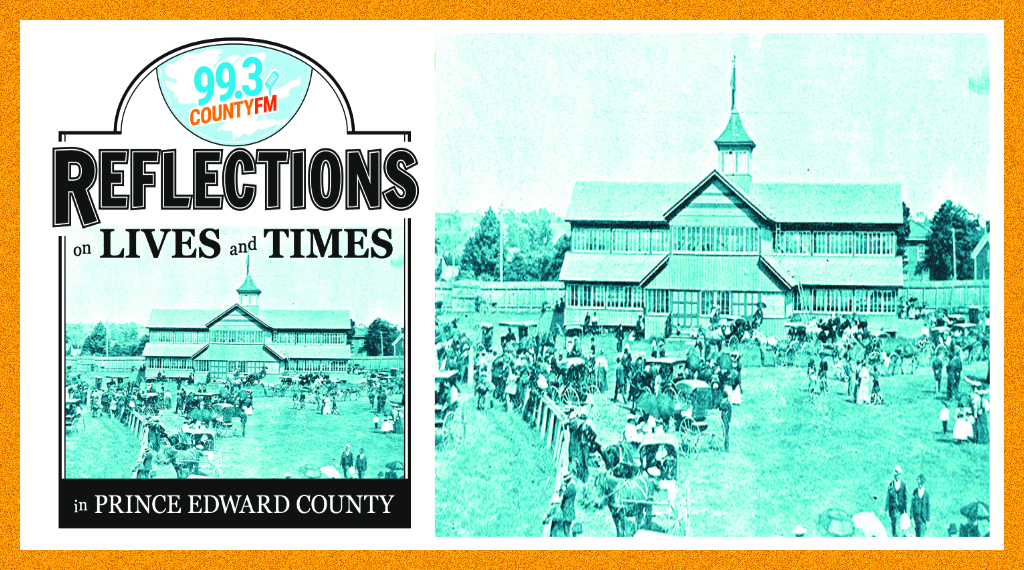The County’s history is filled with interesting, exciting, and important people, stories, and events. 99.3 County FM is pleased to present 23 new radio vignettes based on this long, rich history.
Beverly Sprague, Peter Lockyer, Colleen Johnson, Brenda Shardlow, and Pearl Hucul spent many months researching topics ranging from the Queen’s visit to Main Duck Island, to the life of Peter Martin, the second Indigenous person in Canada to earn a medical degree, to the history of the county’s well loved Mustang Drive-In, as well as many other exciting things.
99.3 County FM is broadcasting these history moments as part of their regular weekday programming Monday-Sunday. The radio series “Reflections on Lives & Times in PEC” is funded by the Government of Canada’s New Horizons for Seniors Program and sponsored locally by Base31 and Edward Jones (Picton).
Sample of “Reflections on Lives & Times in PEC” as broadcast on Grapevine:
The Wellington Masonic Temple and Music Hall. On Consecon Street in Wellington, a large white building has, off and on, been an entertainment venue and Masonic Meeting Hall since 1889. Learn more about the history of one of the neatest and most attractive halls of its size in Central Canada. Researcher: Pearl Hucul.
Learn about Master Shipbuilder John Tait. From Kingston to Picton, John built many of the hundreds of schooners once plying the waters in our area. Learn more about this master ship builder. Researcher: Brenda Sharlow.
When Wellington Went Wet. It wasn’t until 1934 that legislation allowed drinking in public bars in Ontario. Even after that, Wellington steadfastly maintained its “dry” state. Researcher: Pearl Hucul
Tale of Two Rivals. A meandering stream led to a bitter fight between two families. Ironically the rivals were laid to rest side by side in a little graveyard that straddles both properties. Researcher: Brenda Shardlow.
Brickman Canning. There was a time when the canning industry was the dominant industry in PEC. Between the early 1880s up until the 1960s, the area was such a major producer of canned goods such as peas, corn, tomato and pumpkin that it was known as the “Garden County of Canada.” Researcher: Bev Sprague.
White Chapel. Variously known as the Old Chapel or the Conger Chapel, its unassuming exterior exudes a sense of antiquity, a portal to a bygone era. But behind its weathered façade lies a rich tapestry of faith, devotion, and community spirit that has transcended the ages. Researcher: Brenda Shardlow.
Quinte Skiff Club. The Ayle of Quinte Skiff Club rows out of Waupoos Marina, bringing camaraderie, adventure, and seafaring adventure to the County. Their vessel is the Saint Ayles Skiff, bridging Scottish tradition with modern passions. Researcher: Brenda Shardlow.
Dutch Immigration. Thousands of Dutch immigrants settled in Canada after WW2. The DeVries family settled in the County – Interview DeVries family members. Researcher: Pearl Hucul.
Demorestville Town Hall. In the late 1800s, it was clear the Demorestville community wanted — and needed — a Town Hall of their own. Residents twice petitioned for it, and in 1874, the Ontario government made $40,672 available for its construction. Researcher: Bev Sprague.
Queens Main Duck. Just off the coast of Prince Edward County is Main Duck Island. Parks Canada purchased the island in 1977 and incorporated them into St. Lawrence Islands National Park. Researcher: Colleen Johnson.
Reuben Pearce. Reuben Pearce fought in the civil war. His journey from Prince Edward County to the United States and back to his farm in Wellington spanned several years. taking him from a farmer’s field to the battlefield, Confederate prison camps, field hospitals, and back to the farm as he made the long slow journey home. Researcher: Colleen Johnson.
John Tait. If you ask anyone from Kingston to Picton who built any of the hundreds of schooners once sailing in that area and you will likely hear the name John Tait. Researcher: Brenda Shardlow.
Jet Crash History. It’s September 18, 1955. A ten-year-old Terry Sprague is watching television with his family. Their farm lies along the flight path of planes bound for the army base at Picton airport, so it wasn’t unusual to hear the roar of jet engines. But this night was different. Researcher: Colleen Johnson.







